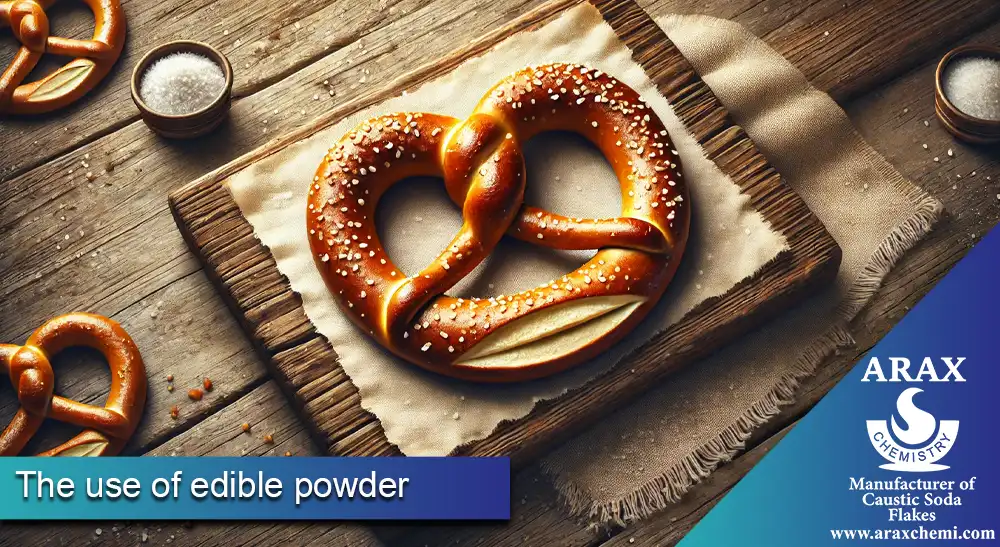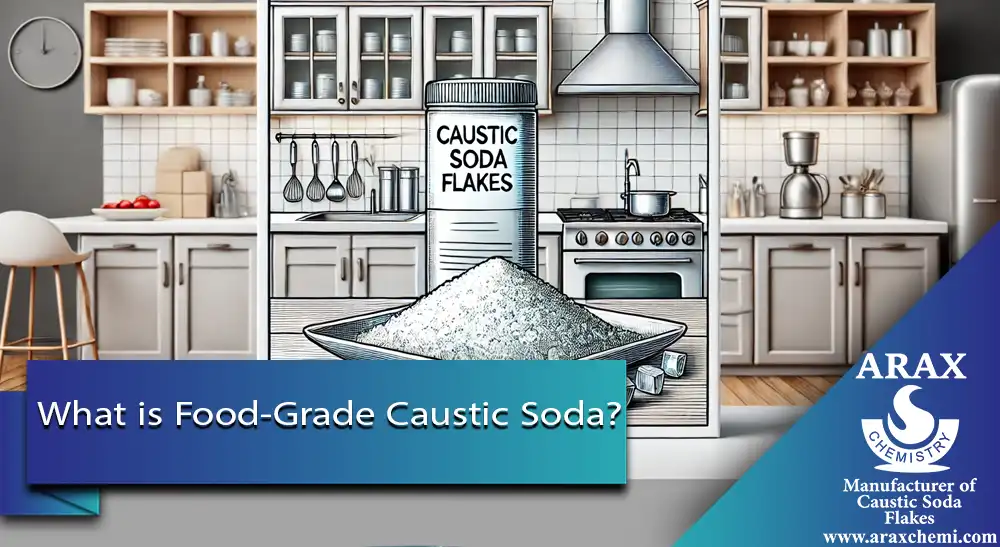Imagine you are preparing a batch of shiny, delicious pretzels in your kitchen. Something special is needed to give these tasty breads their deep brown color and glossy surface. This is where food-grade caustic soda comes into play. Also known as sodium hydroxide (NaOH), this chemical is a vital ingredient in the food industry, particularly for making certain food products. This article will answer the question, “What is food-grade caustic soda?” and explore its differences from regular caustic soda.
What is Food-Grade Caustic Soda?
Food-grade caustic soda, or sodium hydroxide (NaOH), is a unique and powerful alkaline compound available in white crystals or solid flakes. Its high purity level, over 99%, and absence of harmful impurities such as heavy metals and toxins, make it safe for human consumption. This sets it apart from regular caustic soda, which may contain more impurities and is mainly used in chemical industries and for non-food applications.
Differences Between Food-Grade Caustic Soda and Regular Caustic Soda
Caustic soda (sodium hydroxide) is divided into two main categories:
- Food Grade Caustic Soda
- Regular Caustic Soda
Both types are chemically similar but differ in their purity levels.
Purity and Composition in Food-Grade Caustic Soda
- High Purity: Food-grade caustic soda typically has a purity level of over 99%. This ensures it is free from harmful impurities such as heavy metals and toxic substances, making it safe for human consumption.
- The production of food grade caustic soda is a closely monitored and controlled process. This ensures that no harmful substances or contaminants are present, maintaining its high purity and safety for human consumption.
Purity and Composition in Regular Caustic Soda
- Lower Purity: Regular caustic soda may have a lower purity level and contain various impurities that make it unsuitable for human consumption.
- Industrial Composition: This type of caustic soda may contain compounds used in different industrial applications, making it more suitable for non-food uses.
Applications of Food-Grade Caustic Soda
The use of caustic soda is not limited to pretzels. This remarkable substance is also employed in olive processing and caramel production. Although caustic soda is known for its strong alkalinity, it can be crucial in cooking and the food industry when used correctly and in small quantities.

Making Pretzels and Baked Goods
Preparing German pretzels is one of the most common applications of food-grade caustic soda. It helps the pretzel dough achieve a shiny, dark brown crust. This feature enhances the visual appeal of pretzels and improves their flavor and texture. It is important to note that very small amounts of caustic soda should be used.
Processing Olives and Other Fruits
Food grade caustic soda is used in olive processing to remove their natural bitterness. Olives are soaked in a caustic soda solution for several hours or even days, then rinsed with water to eliminate the bitterness, resulting in a milder taste and better edibility. Additionally, caustic soda can process other fruits, reducing their bitterness or firmness, thus improving their flavor and texture.
Making Caramel and Chocolate
Food-grade caustic soda is used in the food industry to process caramel and chocolate. It helps control the pH levels and speeds up the production process. Precise pH adjustment can enhance the flavor and texture of caramel and chocolate, resulting in higher-quality products. Using caustic soda in caramel production ensures a more uniform color and taste.
Processing Cocoa and Chocolate
In the cocoa and chocolate production industry, food-grade caustic soda improves fermentation and reduces cocoa acidity. This process enhances the flavor and aroma of the final chocolate product. By reducing cocoa’s acidity, food-grade caustic soda produces a milder, more pleasant taste in the final product.

Physical and Chemical Properties
Food grade caustic soda is a solid at room temperature with a melting point of 318 degrees Celsius and a boiling point of 1388 degrees Celsius. It dissolves easily in water, alcohol, and glycerol, producing a highly alkaline solution that can quickly raise the pH level of the environment.
Standards for Food-Grade Caustic Soda
Food-grade caustic soda must meet stringent standards to ensure it is safe for human consumption. These standards include a minimum purity of 99% and the absence of harmful impurities such as heavy metals and toxic substances.
How is Food-Grade Caustic Soda Made?
Food caustic soda, also known as sodium hydroxide (NaOH) or caustic soda, is produced through a precise and controlled chemical process to ensure it is safe for human consumption. This meticulous production process involves the following steps:
- Electrolysis of Salt Solution:
The first step in producing food-grade caustic soda is the electrolysis of a sodium chloride (table salt) solution. This process occurs in an electrolytic cell that contains an anode and a cathode:
2NaCl+2H2O→2NaOH+Cl2+H2
In this reaction, sodium chloride (NaCl) dissolves in water, and an electric current is passed through the solution, resulting in the production of sodium hydroxide (NaOH), chlorine gas (Cl2), and hydrogen gas (H2). - Separation and Purification:
After producing sodium hydroxide through electrolysis, the next step is separation and purification. This involves separating sodium hydroxide from the electrolytic solution and removing impurities. This process includes multiple purification stages to ensure the final product is high purity. - Evaporation and Concentration:
The sodium hydroxide solution produced needs to be converted into solid flakes. To achieve this, the solution is transferred to an evaporator to remove water, increasing the solution’s concentration. At this stage, sodium hydroxide becomes a concentrated liquid. - Cooling and Flaking:
The concentrated sodium hydroxide solution is then transferred to a cooling unit, where it quickly cools and forms solid flakes. These flakes are then dried and packaged as the final product.
Safety and Standards
Producing food-grade caustic soda requires adherence to strict health and safety standards to ensure the final product is safe for human consumption. These standards include the following:
- High Purity: Food grade caustic soda must have a purity of over 99%.
- Free from Impurities: The final product should not contain heavy metals or toxic substances.
- Proper Labeling: Product packaging must include complete information about its purity and safety.
Benefits and Weaknesses of Using Food Grade Caustic Soda in Industry
Food-grade caustic soda offers several advantages and disadvantages that must be considered:

Benefits
Food caustic soda has a wide range of applications in different industries, including making pretzels, processing olives, and producing caramel. This versatility is one of its most intriguing aspects, making it a valuable ingredient in the food industry.
pH Regulation: As a strong alkaline agent, it can quickly adjust the pH levels of solutions and be beneficial in various chemical processes.
Weaknesses
Safety Hazards: Food-grade caustic soda is a strong alkaline agent that can cause severe chemical burns. Therefore, appropriate safety precautions and protective equipment must be used when handling it.
Environmental Impact: Improper disposal of caustic soda can lead to environmental pollution. Therefore, using suitable disposal methods and considering environmental factors are essential.
Conclusion
Food-grade caustic soda is a powerful and versatile chemical that can improve the quality and variety of food products when used safely. From making delicious pretzels to processing olives and producing caramel, caustic soda plays a vital role in the food industry. However, its use requires special attention and safety measures to prevent accidents and ensure a safe and high-quality product. We hope this article has provided valuable information about food-grade caustic soda and its applications in the food industry.
FAQs
- What is food-grade caustic soda, and what are its uses?
Food-grade caustic soda is a strong alkaline compound used in the food industry for processing olives, making pretzels, and improving the taste and texture of food products. - What is the difference between food-grade caustic soda and regular caustic soda?
Food-grade caustic soda has higher purity and is free from harmful impurities, making it safe for human consumption. In contrast, regular caustic soda may contain more impurities and is used mainly in chemical industries. - How should food-grade caustic soda be used safely?
Use gloves, safety goggles, and appropriate clothing when handling food-grade caustic soda. Work in a well-ventilated area and clean the workspace with acidic solutions like vinegar afterward.

